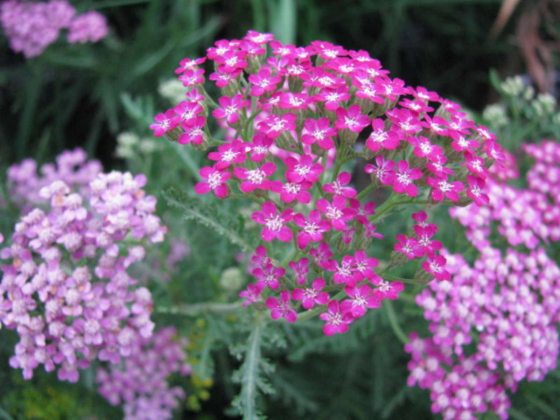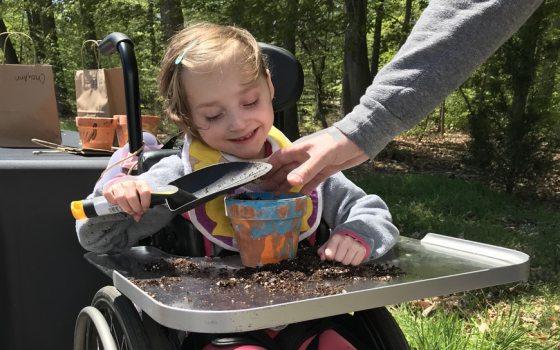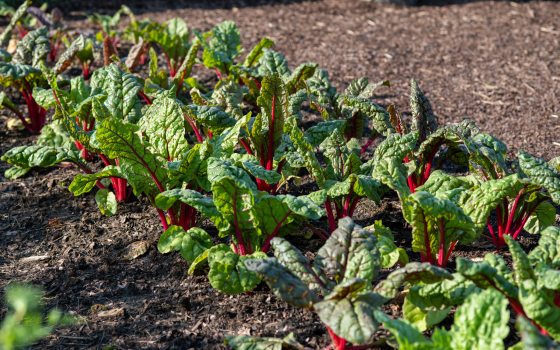Research indicates that while many environments can promote healing, gardens are particularly ideal spaces of well-being, as we are hard-wired to find nature calming and soothing. Gardens not only provide psychological, emotional, and spiritual benefits, but exploring or caring for a garden also reaps the physical benefits of exercise, which in turn can elevate mood. A type of garden or green space that promotes healing and provides an improvement in overall well-being—and one often found in hospitals and healthcare facilities—is termed a “healing garden.” By following basic design principles and listening to your own needs and intentions, you can create your own healing garden that best speaks to you.
Longwood Horticulture Assistant and certified herbalist Susan Meyers, who has been studying the medicinal and therapeutic uses of plants for more than a decade, believes that, above all, a healing garden is one that must speak to you in its physical design and achieve its intended positive health outcome, be it stress relief, engagement with nature, an opportunity for movement and exercise, or other intention. Following a few simple design practices can help you create a healing garden ideally suited for your needs.

When planning your garden, Meyers suggests first taking a trip down memory lane. “Memories are affected by aromas, visuals, and sounds,” Meyers shares. “Think about a memory from your childhood that sparks good feelings. Did you climb a certain tree that brings back good memories? Is there a culinary herb you remember cooking with? Was there a plant you had in your backyard, or flowers that your grandmother used to grow? Just seeing those specific trees or plants can resurface those good memories, and these all play a role in how people feel.”
When creating a healing garden, choose a palette that’s pleasing to you. Choose hues that you want to see; bright colors can brighten your day. Also take note of texture when choosing plants for your healing garden. Avoid plants with thorns or spiny plants that could discourage interacting with the garden. Since most aromatic plants release their scent when touched, plant these where they are most likely to be brushed against, such as paths, steps, or beside a bench. Studies have shown that fragrance in certain herbs, such as lavender (which is relaxing and uplifting) and rosemary (which is great for the memory), stimulates your neurotransmitters, bringing you to a certain state of feeling.

Add in height. “When creating any garden, you’ll want to include height into the space to provide much-needed interest to an otherwise flat landscape,” says Meyers. This added vertical interest draws your eye to the sky for a more serene visual experience.
Integrate culinary herbs and ornamental perennials and shrubs that suit your needs and that you can care for and, possibly, use outside of the garden as well, to further your connection with nature. If you’d like to grow culinary herbs in your healing garden, Meyers suggests the following aromatic perennials that prefer full sun and well-drained soil:
Chives (Allium schoenoprasum) produce beautiful, pillowy purple to pink blooms … and smell fantastic.
Fennel (Foeniculum vulgare), part of the carrot family, adds plenty of height and visual texture to a garden.
Rosemary (Rosmarinus officinalis) of the mint family boasts a pale blue flower and plenty of culinary flavor.
Visually appealing thanks to its gray-green leaves, garden sage (Salvia officinalis) is also a delicious ingredient.
Thyme (Thymus spp.) and oregano (Origanum spp.) add low growing, fragrant foliage, and texture.
If you’re looking for fragrance, consider the following:
Common yarrow (Achillea millefolium) of the aster family is aromatic and delicate in appearance with its cloud-like white flowers.
Lavender (Lavendula spp.) features a wide range of cultivars and plenty of uses, from food to perfume.
With blooms resembling pompoms and leaves that can be used in tea, wild bergamot (Monarda fistulosa) of the mint family adds wonderful texture.
A shrub that’s part of the mint family, chaste-tree (Vitex agnus-castus) can be used as a small accent tree with fragrant, showy purple flowers.
Part of the mint family, anise-hyssop (Agastache foeniculum) features blue to purple showy flowers and fragrant foliage.
Also part of the mint family and typically used in tea, catmint (Nepeta racemosa) features a variety of soft hues and typically reaches peak color between the spring and summer seasons.

To add texture and visual variety to your healing garden, consider the following native flowering perennials and shrubs, which prefer part shade and moist soil:
Wild geranium (Geranium maculatum) with soft purple-pink blooms offers a sweet addition to the garden.
The radiant yellow flowers of the native shrub common witch-hazel (Hamamelis virginiana) are among the last blooms to appear in the fall.
Wild hydrangea (Hydrangea arborescens) is known for its large clusters of early summer flowers.

By incorporating these simple design elements, you can help your garden become a place that ignites your senses and helps to improve your overall sense of well-being. And no matter the garden you choose, Meyers shares, “if you have plants living and breathing beside you, only positive results can come from it.”


